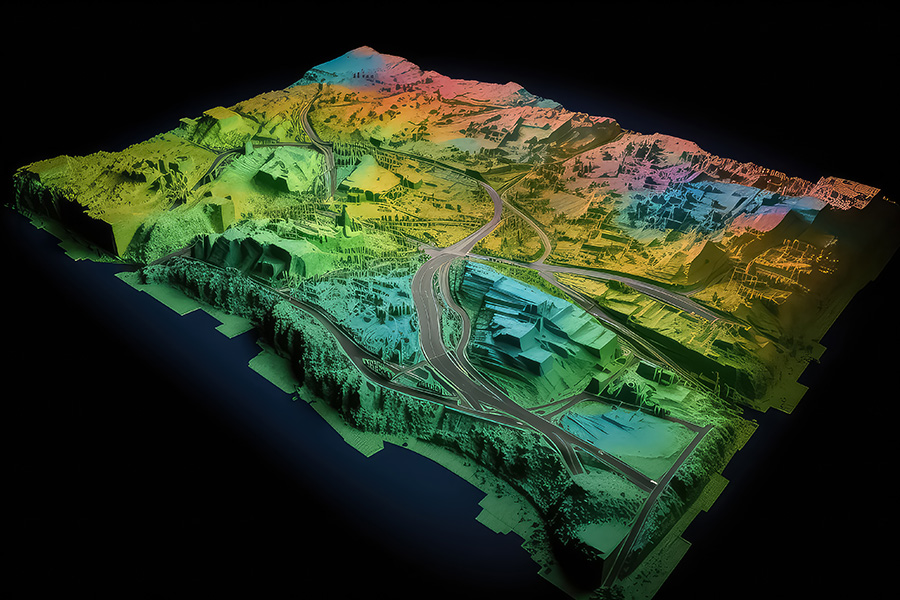We often turn to maps to understand the world around us. Whether planning our daily commute, analyzing weather patterns, or managing vast territories, maps are important for us. Yet, traditional paper maps have evolved into something far more powerful and versatile—Geographic Information Systems (GIS) mapping. But what is GIS mapping?
In this article, we’ll explore GIS components and functions as well as how they enable data visualization across geographies. We will also delve into the practical applications of GIS in realms such as land surveying, urban planning, and asset management.
By the end, you’ll understand how GIS Mapping seamlessly converts data into visually rich maps, offering invaluable insights. Let’s get started!

What Is GIS Mapping?
In engineering, Geographic Information Systems (GIS) offer a critical framework for collecting, managing, and analyzing geographic data to address complex challenges. This technology acts as a bridge between the physical world and digital data, enabling engineers to gain invaluable insights for various applications.
But what is the purpose of GIS? The primary purpose is to provide engineers with a powerful tool for designing, planning, and optimizing projects with a geographic component. That is, from transportation networks and utility systems to urban development and environmental conservation.
The basic principles of GIS mapping in engineering
Data integration
In engineering applications, GIS integrates diverse datasets, combining information from sources like satellite imagery, GPS surveys, and geological records. By integrating data, GIS allows our engineers at Cypress Engineering to comprehensively visualize project information. This interconnected perspective provides valuable insights that improve engineering analysis and planning.
Geospatial analysis
GIS mapping serves as a toolbox for conducting geospatial analysis. Our engineers can explore datasets related to terrain, infrastructure, climate, and more. Through geospatial analysis, they can identify optimal locations for infrastructure projects, assess environmental impacts, and model potential risks.
Visualization
The power of GIS lies in its ability to transform raw data into visual representations, such as maps and 3D models. These visualizations give our engineers a tangible understanding of project parameters, spatial relationships, and potential challenges. This visual perspective enhances project planning, collaboration, and communication.
Components of GIS Mapping in Engineering
-
Spatial data
GIS mapping is built upon a foundation of spatial data. This type of data represents the physical characteristics of the Earth’s surface and its features.
Civil engineers rely on spatial data to create accurate topographic maps, determine land contours, and assess the feasibility of construction sites. Such data encompasses geographic coordinates, elevations, land boundaries, and more, providing the spatial framework for various engineering applications.
-
Attribute data
Alongside spatial data, attribute data is crucial in engineering GIS mapping. This type of data provides additional information about the spatial features, serving as the descriptive component of the geospatial dataset.
In engineering, attribute data can include details such as material properties, structural specifications, or environmental characteristics. For example, structural engineers use attribute data to catalog the materials used in a bridge or building, making monitoring maintenance needs and planning for improvements easier.
-
Geospatial analysis tools
The tools and capabilities within GIS mapping software are integral components for engineers. These tools allow engineers to conduct geospatial analysis, which involves assessing, processing, and interpreting the data. Within the engineering domain, these tools are vital for site selection, risk assessment, and impact analysis.
For instance, consider a project like developing a stormwater management system. In this scenario, environmental engineers employ these tools to analyze water flow patterns, identify potential flood-prone areas, and determine effective management strategies.
What’s remarkable is that GIS mapping tools assist engineers in making informed decisions based on data. This ensures the accuracy, safety, and environmental soundness of their projects. They seamlessly amalgamate various data sources, offering engineers a comprehensive overview of their project area.
Applications of GIS Mapping in Engineering
Urban planning and land management
In civil engineering, GIS mapping is crucial in urban planning and land management. By harnessing the power of geographic information systems, engineers can efficiently design and develop urban spaces.
GIS aids in zoning, land use planning, and infrastructure development, ensuring that cities are designed for optimal functionality and sustainability. Whether it’s creating road networks, positioning public facilities, or managing green spaces, GIS technology offers valuable insights that enhance urban landscapes.

Environmental monitoring and conservation
Environmental engineering relies heavily on GIS mapping to monitor and conserve natural resources. Engineers use geospatial data to track environmental changes, from land use shifts to climate change’s impact.
For example, GIS technology enables the assessment of pollution sources, the monitoring of wildlife habitats, and the prediction of natural disasters. In addition, it aids in designing efficient waste management systems and identifying areas for reforestation. This ultimately contributes to a greener, more sustainable world.
Transportation and logistics
Transportation engineering is intrinsically linked to GIS mapping, as it enhances the planning and management of transportation systems. From road networks to public transit systems, geospatial data assists in optimizing routes, reducing congestion, and ensuring safe transportation.
At Cypress Engineering, our engineers use GIS to analyze traffic patterns, assess the structural integrity of bridges and roads, and determine locations for new infrastructure developments. This application not only improves transportation efficiency but also enhances safety and accessibility.
Emergency management and disaster response
During times of crisis, GIS mapping becomes an invaluable tool for disaster response and recovery efforts. Civil engineers rely on geospatial data to assess the impact of natural disasters, manage resources, and plan evacuation routes.
Moreover, GIS technology assists in coordinating emergency services, tracking the spread of wildfires or floods, and identifying vulnerable areas in the aftermath of disasters. This application saves lives and minimizes damage, underscoring the critical role of GIS mapping in engineering for the greater good.
Data Sources for GIS Mapping
Satellite imagery and aerial photography
Satellite imagery and aerial photography are foundational data sources for GIS mapping. These high-resolution visual resources provide an accurate depiction of the Earth’s surface.
Our engineers use satellite and aerial data for tasks like land surveying, monitoring construction progress, and planning infrastructure projects. This valuable information is essential for enhancing the precision and effectiveness of engineering endeavors.
GPS data
The Global Positioning System (GPS) is an essential tool for obtaining precise geospatial data. It allows engineers to collect location-specific information that is necessary for infrastructure design and construction.
GPS data integration into GIS mapping significantly improves the accuracy and efficiency of engineering projects whether it’s surveying land, assessing transportation routes, or tracking assets.
Publicly available geospatial data
Accessibility to publicly available geospatial data has transformed the field of civil engineering. Various government agencies, organizations, and open-source platforms provide a wealth of data that our engineers can harness.
These sources include topographic maps, climate data, and land use information, enabling engineers to make informed decisions without the burden of extensive data collection.
User-generated data and crowd-sourcing
With the rise of mobile technology and crowd-sourcing platforms, user-generated data has gained prominence in GIS mapping. Through applications like crowd-sourced traffic data and location-based reviews, our engineers can gather real-time information.
This can enhance transportation planning, urban development, and infrastructure maintenance. The dynamic data source fosters community engagement and empowers engineers with invaluable insights.
Challenges and Limitations in GIS Mapping for Civil Engineering
Data quality and accuracy
One of the primary challenges in GIS mapping is ensuring the quality and accuracy of geospatial data. Inaccurate data can lead to faulty engineering designs and costly errors. At Cypress Engineering, we implement data validation and verification processes to guarantee the reliability of information used for decision-making.
Data integration
Integrating data from diverse sources and formats can be a complex undertaking. Engineers often encounter challenges in harmonizing data to create a unified information system. This requires our engineers to use their expertise in data processing and the use of standardized formats for compatibility.
Privacy and ethical considerations
As GIS mapping becomes increasingly sophisticated, privacy and ethical concerns emerge. Collecting and using location-based data raises questions about individual privacy and data security. Civil engineers must navigate these ethical considerations while responsibly handling geospatial information.
Technical requirements and costs
The adoption of GIS technology necessitates specific technical requirements and investments. This includes acquiring the appropriate software, hardware, and training for engineering professionals. The associated costs can be a limiting factor for smaller engineering firms and organizations.
Future Trends in GIS Mapping for Civil Engineering
Rapid technological advancements mark the future of GIS mapping in civil engineering. Enhanced data collection methods, more accessible satellites, and improved processing capabilities are expanding the horizons of GIS applications. Engineers can look forward to even more sophisticated tools for decision-making.

Increasing role in decision-making processes
GIS mapping is poised to play an increasingly important role in engineering decision-making processes. It empowers our engineers to make well-informed choices by providing comprehensive geospatial insights.
Furthermore, GIS technology ensures engineering decisions are based on real-world data. This improves the effectiveness of projects, from urban planning to disaster response.
The future of GIS mapping is exciting with advancing technology and data availability. GIS is expanding its role in decision-making processes. These developments will enhance the precision and efficiency of engineering projects. They will also contribute to bettering communities and the environment overall.
GIS Mapping in Infrastructure Development
In the field of civil engineering, GIS mapping is crucial since it greatly aids in the planning and building of infrastructure projects.
Let us explore how GIS mapping plays key roles in urban planning, transportation projects, and environmental conservation.
GIS mapping in urban development
Urban areas are dynamic and ever-evolving landscapes, often characterized by rapid population growth and complex spatial challenges. GIS mapping is an indispensable tool for urban planners and civil engineers working to manage this complexity. So, here’s how it contributes:
- Land use planning – Assess land use patterns, identify vacant areas suitable for development, and designate land for specific purposes like residential, commercial, or green spaces.
- Infrastructure planning – It aids our engineers in designing infrastructure elements like roads, bridges, sewage systems, and utility services. Planners can assess the spatial distribution of these elements to optimize resource allocation.
- Zoning and regulation – GIS mapping is used to restrict zoning areas and enforce land use regulations, ensuring that developments comply with local laws and regulations.
- Emergency response – Quick response to emergencies is crucial in urban environments. GIS mapping assists in emergency response planning, facilitating swift evacuation routes, medical service access, and disaster management.
GIS mapping in transportation projects
Transportation systems form the lifelines of urban and rural areas. Hence, efficient planning and execution are essential. Here’s how GIS mapping contributes to this critical area:
- Route planning – GIS mapping evaluates potential routes for new roads, highways, railways, or public transportation systems. Engineers assess factors like terrain, existing infrastructure, and environmental impact.
- Traffic management – Real-time data collected through GIS mapping helps manage traffic flow, providing information on congestion, road conditions, and suggesting alternative routes.
- Asset management – GIS mapping supports managing and maintaining transportation assets. It keeps track of bridges, roads, and transit systems, ensuring they are safe and operational.
- Environmental impact assessment – GIS mapping is invaluable for assessing the environmental impact of transportation projects, allowing our engineers to design routes that minimize harm to ecosystems.
GIS mapping in environmental conservation
Environmental conservation is a global imperative. GIS mapping is essential in preserving natural resources and maintaining ecological balance. So, GIS may help with environmental activities in the following ways:
- Biodiversity and habitat mapping – It helps identify critical habitats and biodiversity hotspots, assisting conservationists in creating protected areas.
- Resource management – GIS mapping monitors and manages natural resources like forests, watersheds, and wetlands. It enables the sustainable use of these resources.
- Disaster mitigation – GIS mapping is a valuable tool for predicting and responding to natural disasters, such as floods, forest fires, and hurricanes. It helps in emergency preparedness and response.
- Climate change analysis – As climate change becomes a growing concern, GIS mapping allows scientists to analyze and visualize its environmental impact.
In essence, GIS mapping is the backbone of infrastructure development. It enhances our ability to plan and execute projects efficiently, ensuring urban development, transportation systems, and environmental conservation are harmonized with the natural world.

Conclusion
GIS mapping is a cornerstone technology across engineering domains, converting spatial data into dynamic visual insights. But what is GIS mapping? At its core, it’s a framework for capturing, organizing, analyzing, and presenting geographic information.
We revealed how it empowers engineering through key capabilities. GIS provides invaluable insights by integrating diverse data sources, conducting geospatial analysis, and generating visual maps.
This versatile technology enables data-driven decisions, giving engineers a comprehensive visual perspective. Simply put, GIS mapping transforms complex geographic data into clear visual intelligence that improves project outcomes.
While certain limitations exist, the continuous advancements in this field promise an even more significant role for GIS mapping in infrastructure development and environmental stewardship.
Here at Cypress Engineering, we recognize GIS as an indispensable part of engineering’s future. It opens doors to profound insights derived from geospatial data.
